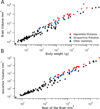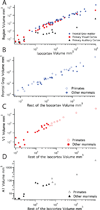Embracing covariation in brain evolution: large brains, extended development, and flexible primate social systems
- PMID: 22230623
- PMCID: PMC3327164
- DOI: 10.1016/B978-0-444-53860-4.00004-0
Embracing covariation in brain evolution: large brains, extended development, and flexible primate social systems
Abstract
Brain size, body size, developmental length, life span, costs of raising offspring, behavioral complexity, and social structures are correlated in mammals due to intrinsic life-history requirements. Dissecting variation and direction of causation in this web of relationships often draw attention away from the factors that correlate with basic life parameters. We consider the "social brain hypothesis," which postulates that overall brain and the isocortex are selectively enlarged to confer social abilities in primates, as an example of this enterprise and pitfalls. We consider patterns of brain scaling, modularity, flexibility of brain organization, the "leverage," and direction of selection on proposed dimensions. We conclude that the evidence supporting selective changes in isocortex or brain size for the isolated ability to manage social relationships is poor. Strong covariation in size and developmental duration coupled with flexible brains allow organisms to adapt in variable social and ecological environments across the life span and in evolution.
Copyright © 2012 Elsevier B.V. All rights reserved.
Figures







Similar articles
-
Why big brains? A comparison of models for both primate and carnivore brain size evolution.PLoS One. 2021 Dec 21;16(12):e0261185. doi: 10.1371/journal.pone.0261185. eCollection 2021. PLoS One. 2021. PMID: 34932586 Free PMC article.
-
Visual specialization and brain evolution in primates.Proc Biol Sci. 1998 Oct 22;265(1409):1933-7. doi: 10.1098/rspb.1998.0523. Proc Biol Sci. 1998. PMID: 9821360 Free PMC article.
-
The evolution of the social brain: anthropoid primates contrast with other vertebrates.Proc Biol Sci. 2007 Oct 7;274(1624):2429-36. doi: 10.1098/rspb.2007.0693. Proc Biol Sci. 2007. PMID: 17652066 Free PMC article.
-
Evolution of the brain and intelligence in primates.Prog Brain Res. 2012;195:413-30. doi: 10.1016/B978-0-444-53860-4.00020-9. Prog Brain Res. 2012. PMID: 22230639 Review.
-
Social components of fitness in primate groups.Science. 2007 Sep 7;317(5843):1347-51. doi: 10.1126/science.1140734. Science. 2007. PMID: 17823344 Review.
Cited by
-
A volumetric comparison of the insular cortex and its subregions in primates.J Hum Evol. 2013 Apr;64(4):263-79. doi: 10.1016/j.jhevol.2012.12.003. J Hum Evol. 2013. PMID: 23466178 Free PMC article.
-
Maternal investment, life histories and the evolution of brain structure in primates.Proc Biol Sci. 2019 Sep 25;286(1911):20191608. doi: 10.1098/rspb.2019.1608. Epub 2019 Sep 18. Proc Biol Sci. 2019. PMID: 31530145 Free PMC article.
-
Evolution of the human brain: when bigger is better.Front Neuroanat. 2014 Mar 27;8:15. doi: 10.3389/fnana.2014.00015. eCollection 2014. Front Neuroanat. 2014. PMID: 24723857 Free PMC article. Review.
-
When ontogeny recapitulates phylogeny: Fixed neurodevelopmental sequence of manipulative skills among primates.Sci Adv. 2020 Jul 24;6(30):eabb4685. doi: 10.1126/sciadv.abb4685. eCollection 2020 Jul. Sci Adv. 2020. PMID: 32754638 Free PMC article.
-
Comparison of Dolphins' Body and Brain Measurements with Four Other Groups of Cetaceans Reveals Great Diversity.Brain Behav Evol. 2016;88(3-4):235-257. doi: 10.1159/000454797. Epub 2017 Jan 26. Brain Behav Evol. 2016. PMID: 28122370 Free PMC article.
References
-
- Aboitiz F. Does bigger mean better? Evolutionary determinants of brain size and structure. Brain, Behavior and Evolution. 1996;47:225–245. - PubMed
-
- Aiello LC, Wheeler P. The expensive-tissue hypothesis: The brain and the digestive system in human and primate evolution. Current Anthropology. 1995;36:199–221.
-
- Anderson ML. Neural reuse: A fundamental organizational principle of the brain. The Behavioral and Brain Sciences. 2010;33:245–266. discussion 266–313. - PubMed
-
- Armstrong E. A look at relative brain size in mammals. Neuroscience Letters. 1982;34:101–104. - PubMed
-
- Barton RA. Independent contrasts analysis of neocortical size and socioecology in primates. The Behavioral and Brain Sciences. 1993;16:694–695.
Publication types
MeSH terms
Grants and funding
LinkOut - more resources
Full Text Sources

